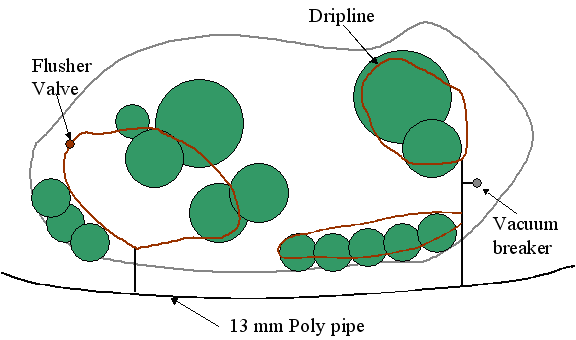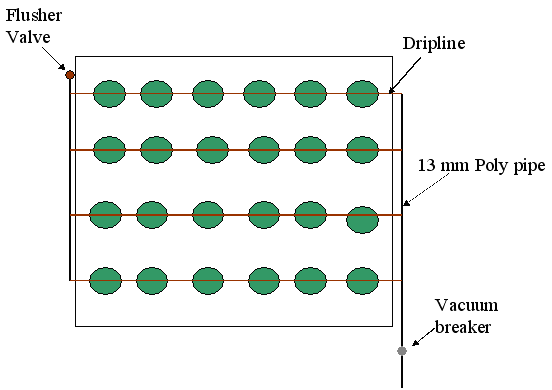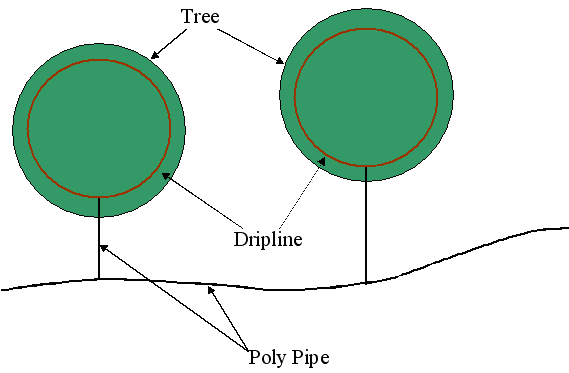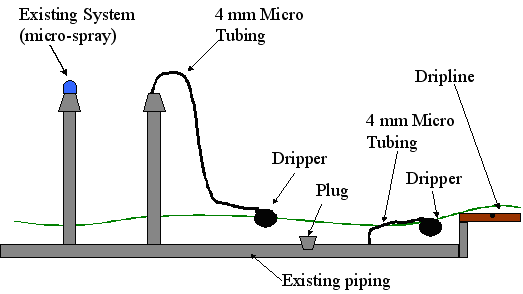For many of us, watering the garden has always been a bit of a “hit and miss”, and all too often it seems like too much hard work. To take the stress out of watering (for both you and your garden), why not whack in a subsurface watering system, one that delivers water directly to the roots of the plant via drippers. They are neat, tidy and sustainable and will help to reduce water wastage in the garden. But best of all they are not that hard to install. Our sustainable subsurface irrigation installation guide will help you make the most of your water in the patch.
So, how do we do it? Well, these types of systems, using either a pre-fabricated dripline, drippers or porous “weeping” hose are generally best installed before the garden is planted out, although they can be laid in an existing garden (just be careful not to tread on your precious plants or disturb shallow roots). Installation is dead easy, and requires laying the dripline on top of the soil at an appropriate distance from the plants that need watering. Once this is completed, be sure to cover the dripline system with mulch. Installing these systems on top of soil and under mulch will help reduce evaporation, and direct the water where it is needed most – the roots!
As the water from each dripper will spread out and down into the soil, it is important to know you soil type, and lay out your dripline accordingly (depending on the soil type the water can spread up to one metre from each dripper!). Knowing your soil type will determine the ideal distance between dripline, so use the following as a rough guide:
Clay soil – dripline spacing 50-100cm
Loam soil – dripline spacing 40-80cm
Sandy soil – dripline spacing 30-60cm
Using the right spacing ensures that all the soil area between parallel lengths of dripline receives water. However this can be regulated if there are areas of the garden that require less water, or no water at all (eg: pathways, fallow areas etc). In these cases, either reduce the number of drippers in the line or, if using pre-fabricated dripline, cut out the “unneeded” section of the drip line, and replace with a section of un-perforated poly pipe, using a joiner of appropriate size. The most common prefabricated dripline size used in garden irrigation is the 13mm width. This is an industry standard sizing for garden irrigation equipment and piping. There is a massive range of joiners, elbows (corners) and accessories available to configure the most complex dripline systems. Have a look in your local independent hardware or SGA Certified Garden Centre for a full range of wonderful, watering, wizardry and awesome dripline accessories.
Dripline is best laid in either a grid or loop pattern depending on the shape of the garden bed. Looping the dripline back onto itself or into a poly pipe main line helps to maintain similar pressure over the entire line. If the dripline runs are longer than 50 metres, or travel up and down undulating terrain, it is best to use specific pressure compensated (PC) drippers or pre-fabricated dripline. Selecting these will ensure that the same amount of water is distributed evenly across the entire irrigation system. Sure, these PC drippers and dripline may cost a bit more, but it’s worth it in the long run, for the sake of even garden watering.
Garden Bed Arrangement
If the dripline is to be installed in an existing or new garden bed, especially those that are not densely planted, consider the layout below. The dripline (brown) is looped around trees and stands of shrubs, and feeds back onto itself, and into a 13mm poly pipe mainline (black). It is this poly pip line that runs from the tap, and is un-perforated, meaning there is no unnecessary water loss. This system also has a flusher valve and vacuum valve installed, more on these later.

Vegie Patch or Lawn Arrangement
This layout is great for vegie patches or densely planted garden beds, and again utilises the 13mm poly pipe mainline (black) with the 13mm dripline (brown) feeding back into the system at each end, ensuring greater water flow and more consistent watering. The flusher valve and vacuum valve are also present in this layout.

Trees
In addition to trees, this layout can also be used for pots and hanging baskets. The dripline (brown) feeds back into itself, and then into the 13mm poly pipe mainline (black). If utilising this type of set-up for pots, consider using pre-fabricated dripline in a 4mm width. Also known as “spaghetti pipe” 4mm dripline and poly pipe is incredibly flexible, and allows a great deal of malleability and shaping, while still delivering a good volume of water to the pot. 4mm piping is readily available, as are the appropriate joiners and fittings to run this size line from a standard 13mm mainline.

Converting an existing spray system
Loads of us have existing sprinkler systems in the garden already, many of which are in pretty good working order, and well set up. Water restrictions in many areas of Australia prevent the use of these, and, quite honestly, they are not that efficient anyway. Before you go nuts and rip the whole she-bang out of the ground, there are a number of methods to convert your existing spray system to a drip system, and it’s not as hard as you may think! The diagram below has a number of options, and, depending on your situation, one or a combination these solutions may be appropriate.

Drip System Accessories

Flusher valves (left) should be used at the end of lines to remove any grit that may enter the system. The valves begin open when the system is activated and then shut of after a couple of minutes.

Vacuum breakers (right) are placed at the highest point along the system and stop the drippers from syphoning dirt and mud into the line when it is switched off.

Pressure reducers (left) may be necessary in areas of high pressure. Install these at the start of the line before the drippers. Automated systems may require the solenoids to be turned down. On manual systems simply turn down the tap.

In-line filters (right) should be installed at the start of the irrigation line to remove any dirt or debris before it enters the system.
Related Articles:
Thriving in the Heat: Managing Plant Heat Stress
As the mercury rises, your garden confronts the challenge of heat stress. Understanding how various plants respond to heat and employing appropriate…
Water Smart Gardening 101 Video
Sustainable Gardening 101 Video Series PART 4: Water Smart Gardening As the climate changes we need to take extra care to design water smart gardens.…



